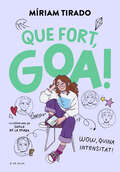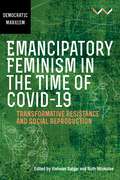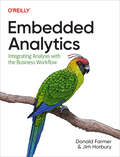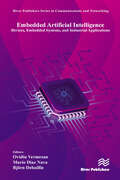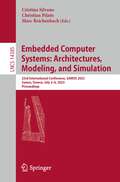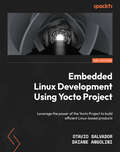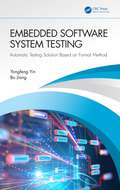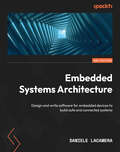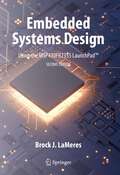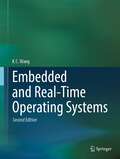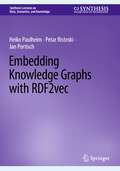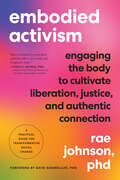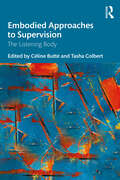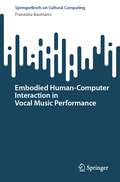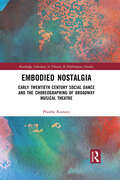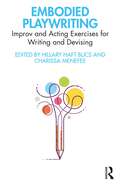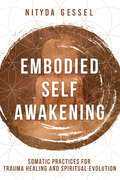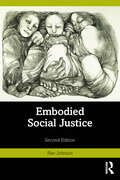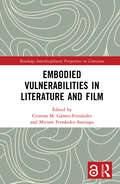- Table View
- List View
Elvis at 21: New York to Memphis
by Insight EditionsIn 1956, photographer Alfred Wertheimer was asked to photograph the then twenty-one-year-old Elvis Presley just as his career was about to explode. This book features the collection of photos taken by Wertheimer, offering a snapshot of the young Elvis Presley&’s remarkable rise to fame and his permanent status as the &“King of Rock &’n&’ Roll.&” In 1956, Alfred Wertheimer was asked by Presley&’s new label, RCA Victor, to photograph Elvis Presley&’s budding career just as it was about to take off in a way the world had never seen. With unimpeded access to the young performer, Wertheimer captured unguarded and everyday moments in Elvis&’s life during that crucial year. It was a year that took him from Tupelo, Mississippi, to the silver screen, the verge of international stardom, and his crowning as the &“King of Rock 'n' Roll.&” As Wertheimer photographed Elvis during 1956, and again in 1958, he created classic images that are spontaneous, unrehearsed, and without artifice. A PIVOTAL YEAR: Dubbed the &“King of Rock &’n&’ Roll&” in 1956, 21-year-old Elvis, placed 17 songs on Billboard&’s Top 100 singles chart, including 3 singles that reached #1, appeared multiple prime-time TV variety shows, performed 143 times in 79 different cities, and released his first film, Love Me Tender EXCLUSIVE PHOTOS: Dive into the complete collection of Alfred Wertheimer&’s photos of the young Elvis Presley as he tours from New York to Memphis, Tennessee PERFECT FOR ALL ELVIS FANS: Fans of all ages will enjoy this exclusive deep dive into Elvis&’s early life as he builds his career and shakes up the world of music GO BEHIND THE STAGE: Explore intimate and candid images captured after Elvis has left the building—backstage, writing, or reading fan mail from his admirers RENOWNED PHOTOGRAPHER AND AUTHOR: Experience the King of Rock &’n&’ Roll through the lens of famed Alfred Wertheimer, the photographer who captured every moment of the young star&’s early career
Em dic Goa 2 - Que fort, Goa! (Em dic Goa #Volumen 2)
by Míriam TiradoEl segon títol de la sèrie Em dic Goa, que ha captivat la imaginació de milers de joves lectors. «Primer dia d'institut... Nerviosa, jo? Que dius! És només que aquest any ha estat ple de canvis: tinc companys nous, la meva amiga Nadia ha anat a un altre insti, el meu germà és a punt de néixer i després està en Klaus… que no sé què passarà entre nosaltres. A més, crec que la meva mare té nòvio!Les coses estan canviant massa ràpid... Que fort tot!» Un inici de curs ple d’emocionar per a la Goa i els seus amics, un grup que serà clau per surfejar tot el que passa quan tens 12 anys. La Goa seguirà compartint els seus pensaments i emocions al diari que grava per a ella mateixa. Tant de bo la vida tingués un manual d’instruccions! Continua la primera sèrie juvenil de l’aclamada autora Míriam Tirado, autora d’El fil invisible, Sensibles i La font amagada.
Em dic Goa: El dia que es va parar el món
by Míriam TiradoEm dic Goa i, literal... no entenc la vida! «GOA. Sí, ja ho sé... Quin nom més estrany! La meva vida ara mateix és un drama: des que els meus pares es van separar, ha canviat tot! No em pensava pas que tenir dotze anys seria tan complicat... De debò, per què les coses no poden ser com abans? Necessito un descans!»La Goa és una adolescent que acaba de fer 12 anys i veu com la seva vida fa un gir inesperat de la nit al dia: els seus pares s'han separat, ara tenen dues cases i tota la seva vida repartida entre elles. A més, el seu pare està esperant un fill amb la seva nova parella, així que... la Goa tindrà un germanet! Quantes coses per tenir només 12 anys. La Goa només vol estar tranquil·la i que la deixin estar una estona amb la tablet per expressar tot el que li passa pel cap en un vídeo-diari per a ella mateixa. Perquè créixer no és pas fàcil! Míriam Tirado, autora d'El fil invisible, s'endinsa en el món de l'adolescència amb aquesta sèrie plena d'humor i sensibilitat.
Emancipatory Change in US Higher Education
by Zachary S. Ritter Kenneth R. Roth Felix Kumah-AbiwuThis edited volume explores and deconstructs the possibilities of higher education beyond its initial purpose. The book contextualizes and argues for a more robust interrogation of persistent patterns of campus inequality driven by rapid demographic change, reduced public spending in higher education, and an increasingly polarized political landscape. It offers contemporary views and critiques ideas and practices such as micro-aggressions, implicit and explicit bias, and their consequences in reifying racial and gender-based inequalities on members of nondominant groups. The book also highlights coping mechanisms and resistance strategies that have enabled members of nondominant groups to contest primarily racial- and gender- based inequity. In doing so, it identifies new ways higher education can do what it professes to do better, in all ways, from providing real benefit to students and communities, while also setting a bar for society to more effectively realize its stated purpose and creed.
Emancipatory Feminism in the Time of Covid-19: Transformative resistance and social reproduction (Democratic Marxisms)
by Vishwas Satgar Christine Bischoff Jacklyn Cock Ruth Ntlokotse Hawzhin Azeez Asanda Benya Jane Cherry Samantha Hargreaves Inge Konik Jane Mbithi-Dikgol Courtney Morgan Sonia Phalatse Busi Sibeko Dineo SkosanaThe Covid-19 pandemic showed that a patriarchal capitalist socio-economic system is unable to address the socio-ecological reproduction need of societies. This volume foregrounds the possibilities emancipatory feminism creates by resisting neo-liberalism through grassroots and indigenous activism.The Covid-19 pandemic threw into stark relief the multi-dimensional threats created by neoliberal capitalism. Government measures to alleviate the crisis were largely inadequate, leaving women – in particular working-class women – to carry the increased burden of care work while at the same time placing themselves in direct risk as frontline workers.Emancipatory Feminism in the Time of Covid-19, the seventh volume in the Democratic Marxism series, explores how many subaltern women – working class, peasant and indigenous –challenge hegemonic neoliberal feminism through their resistance to ordinary capitalist practices and ecological extractivism. Contributors cover women’s responses in a wide range of contexts: from women leading the defence of Rojava – the Kurdish region of Syria, to approaches to anti-capitalist ecology and building food secure pathways in communities across Africa, to championing climate justice in mining affected communities and transforming gender divisions in mining labour practices in South Africa, to contesting macro-economic policies affecting the working conditions of nurses. Their practices demonstrate a feminist understanding of the current systemic crises of capitalism and patriarchal oppression. What is offered in this collection is a subaltern women’s grassroots resistance focused on advancing and enabling solidarity-based political projects, deepening democracy, building capacities and alliances to advance new feminist alternatives.
Emandla aSimangaliso
by Sponono Mahlangu TRANSLATED BY Mduduzi Benjie ShongweSiswati – First paragraphs
Embedded Analytics: Integrating Analysis with the Business Workflow
by Donald Farmer Jim HorburyOver the past 10 years, data analytics and data visualization have become essential components of an enterprise information strategy. And yet, the adoption of data analytics has remained remarkably static, reaching no more than 30% of potential users. This book explores the most important techniques for taking that adoption further: embedding analytics into the workflow of our everyday operations.Authors Donald Farmer and Jim Horbury show business users how to improve decision making without becoming analytics specialists. You'll explore different techniques for exchanging data, insights, and events between analytics platforms and hosting applications. You'll also examine issues including data governance and regulatory compliance and learn best practices for deploying and managing embedded analytics at scale.Learn how data analytics improves business decision making and performanceExplore advantages and disadvantages of different embedded analytics platformsDevelop a strategy for embedded analytics in an organization or productDefine the architecture of an embedded solutionSelect vendors, platforms, and tools to implement your architecture Hire or train developers and architects to build the embedded solutions you needUnderstand how embedded analytics interacts with traditional analytics
Embedded Artificial Intelligence: Devices, Embedded Systems, and Industrial Applications
by Ovidiu Vermesan Mario Diaz Nava Björn DebaillieRecent technological developments in sensors, edge computing, connectivity, and artificial intelligence (AI) technologies have accelerated the integration of data analysis based on embedded AI capabilities into resource-constrained, energy-efficient hardware devices for processing information at the network edge. Embedded AI combines embedded machine learning (ML) and deep learning (DL) based on neural networks (NN) architectures such as convolutional NN (CNN), or spiking neural network (SNN) and algorithms on edge devices and implements edge computing capabilities that enable data processing and analysis without optimised connectivity and integration, allowing users to access data from various sources. Embedded AI efficiently implements edge computing and AI processes on resource-constrained devices to mitigate downtime and service latency, and it successfully merges AI processes as a pivotal component in edge computing and embedded system devices. Embedded AI also enables users to reduce costs, communication, and processing time by assembling data and by supporting user requirements without the need for continuous interaction with physical locations. This book provides an overview of the latest research results and activities in industrial embedded AI technologies and applications, based on close cooperation between three large-scale ECSEL JU projects, AI4DI, ANDANTE, and TEMPO. The book’s content targets researchers, designers, developers, academics, post-graduate students and practitioners seeking recent research on embedded AI. It combines the latest developments in embedded AI, addressing methodologies, tools, and techniques to offer insight into technological trends and their use across different industries.
Embedded Computer Systems: 23rd International Conference, SAMOS 2023, Samos, Greece, July 2–6, 2023, Proceedings (Lecture Notes in Computer Science #14385)
by Cristina Silvano Marc Reichenbach Christian PilatoThis book constitutes the proceedings of the 22st International Conference on Embedded Computer Systems: Architectures, Modeling, and Simulation, SAMOS 2021, which took place in July 2022 in Samos, Greece. The 11 full papers and 7 short papers presented in this volume were carefully reviewed and selected from 45 submissions. The conference covers a wide range of embedded systems design aspects, including machine learning accelerators, and power management and programmable dataflow systems.
Embedded Linux Development Using Yocto Project: Leverage the power of the Yocto Project to build efficient Linux-based products, 3rd Edition
by Daiane Angolini Otavio SalvadorElevate your Linux-powered system with Yocto Projects, enhancing its stability and resilience efficiently and economically — now upgraded to the latest Yocto Project versionPurchase of the print or Kindle book includes a free PDF eBookKey FeaturesOptimize your Yocto Project tools to develop efficient Linux-based projectsFollow a practical approach to learning Linux development using Yocto ProjectEmploy the best practices for embedded Linux and Yocto Project developmentBook DescriptionThe Yocto Project is the industry standard for developing dependable embedded Linux projects. It stands out from other frameworks by offering time-efficient development with enhanced reliability and robustness. With Embedded Linux Development Using Yocto Project, you'll acquire an understanding of Yocto Project tools, helping you perform different Linux-based tasks. You'll gain a deep understanding of Poky and BitBake, explore practical use cases for building a Linux subsystem project, employ Yocto Project tools available for embedded Linux, and uncover the secrets of SDK, recipe tool, and others. This new edition is aligned with the latest long-term support release of the aforementioned technologies and introduces two new chapters, covering optimal emulation in QEMU for faster product development and best practices. By the end of this book, you'll be well-equipped to generate and run an image for real hardware boards. You'll gain hands-on experience in building efficient Linux systems using the Yocto Project.What you will learnGet to grips with Poky workflowsConfigure and prepare the Poky build environmentExplore the latest version of Yocto Project through examplesConfigure a build server and customize images using ToasterGenerate images and fit packages into created images using BitBakeSupport the development process by setting up and using Package feedsDebug Yocto Project by configuring PokyBuild and boot image for BeagleBone Black, RaspberryPi 4, and VisionFive via SD cardsExplore the use of QEMU to speed up the development cycle using emulationWho this book is forIf you are an embedded Linux developer and want to broaden your knowledge about the Yocto Project with examples of embedded development, then this book is for you. Professionals looking for new insights into working methodologies for Linux development will also find plenty of helpful information in this book.
Embedded Software System Testing: Automatic Testing Solution Based on Formal Method
by Bo Jiang Yongfeng YinThis book introduces embedded software engineering and management methods, proposing the relevant testing theory and techniques that promise the final realization of automated testing of embedded systems.The quality and reliability of embedded systems have become a great concern, faced with the rising demands for the complexity and scale of system hardware and software. The authors propose and expound on the testing theory and techniques of embedded software systems and relevant environment construction technologies, providing effective solutions for the automated testing of embedded systems. Through analyzing typical testing examples of the complex embedded software systems, the authors verify the effectiveness of the theories, technologies and methods proposed in the book.In combining the fundamental theory and technology and practical solutions, this book will appeal to researchers and students studying computer science, software engineering, and embedded systems, as well as professionals and practitioners engaged in the development, verification, and maintenance of embedded systems in the military and civilian fields.
Embedded Systems Architecture: Design and write software for embedded devices to build safe and connected systems, 2nd Edition
by Daniele LacameraDesign safe and reliable software for embedded systems and explore the internals of device drivers, RTOS, and TEEKey FeaturesIdentify and overcome challenges in embedded environmentsUnderstand and implement the steps required to increase the security of IoT solutionsBuild safety-critical and memory-safe parallel and distributed embedded systemsBook DescriptionEmbedded Systems Architecture begins with a bird's-eye view of embedded development and how it differs from the other systems that you may be familiar with. This book will help you get the hang of the internal working of various components in real-world systems.You'll start by setting up a development environment and then move on to the core system architectural concepts, exploring system designs, boot-up mechanisms, and memory management. As you progress through the topics, you'll explore the programming interface and device drivers to establish communication via TCP/IP and take measures to increase the security of IoT solutions. Finally, you'll be introduced to multithreaded operating systems through the development of a scheduler and the use of hardware-assisted trusted execution mechanisms.With the help of this book, you will gain the confidence to work with embedded systems at an architectural level and become familiar with various aspects of embedded software development on microcontrollers—such as memory management, multithreading, and RTOS—an approach oriented to memory isolation.What you will learnParticipate in the design and definition phase of an embedded productGet to grips with writing code for ARM Cortex-M microcontrollersBuild an embedded development lab and optimize the workflowSecure embedded systems with TLSDemystify the architecture behind the communication interfacesUnderstand the design and development patterns for connected and distributed devices in the IoTMaster multitasking parallel execution patterns and real-time operating systemsBecome familiar with Trusted Execution Environment (TEE)Who this book is forIf you're a software developer or designer looking to learn about embedded programming, this is the book for you. You'll also find this book useful if you're a beginner or a less experienced embedded programmer on a quest to expand your knowledge on embedded systems.
Embedded Systems Design using the MSP430FR2355 LaunchPad™
by Brock J. LaMeres<p>This textbook for courses in Embedded Systems introduces students to necessary concepts, through a hands-on approach.<p> <p>LEARN BY EXAMPLE – This book is designed to teach the material the way it is learned, through example. Every concept is supported by numerous programming examples that provide the reader with a step-by-step explanation for how and why the computer is doing what it is doing.<p> <p>LEARN BY DOING – This book targets the Texas Instruments MSP430 microcontroller. This platform is a widely popular, low-cost embedded system that is used to illustrate each concept in the book. The book is designed for a reader that is at their computer with an MSP430FR2355 LaunchPadTM Development Kit plugged in so that each example can be coded and run as they learn.<p> <p>LEARN BOTH ASSEMBLY AND C – The book teaches the basic operation of an embedded computer using assembly language so that the computer operation can be explored at a low-level. Once more complicated systems are introduced (i.e., timers, analog-to-digital converters, and serial interfaces), the book moves into the C programming language. Moving to C allows the learner to abstract the operation of the lower-level hardware and focus on understanding how to “make things work”.<p> <p>BASED ON SOUND PEDAGOGY - This book is designed with learning outcomes and assessment at its core. Each section addresses a specific learning outcome that the student should be able to “do” after its completion. The concept checks and exercise problems provide a rich set of assessment tools to measure student performance on each outcome.<p>
Embedded and Real-Time Operating Systems
by K. C. WangThis book covers the basic concepts and principles of operating systems, showing how to apply them to the design and implementation of complete operating systems for embedded and real-time systems. It includes all the foundational and background information on ARM architecture, ARM instructions and programming, toolchain for developing programs, virtual machines for software implementation and testing, program execution image, function call conventions, run-time stack usage and link C programs with assembly code.Embedded and Real-Time Operating Systems describes the design and implementation of a complete OS for embedded systems in incremental steps, explaining the design principles and implementation techniques. For Symmetric Multiprocessing (SMP) embedded systems, the author examines the ARM MPcore processors, which include the SCU and GIC for interrupts routing and interprocessor communication and synchronization by Software Generated Interrupts (SGIs).This Second Edition covers ARM64 architecture and programming. These include exception levels, vector tables and exceptions handling, GICv3 programming and interrupt processing. It covers virtual to physical address mappings in ARMv8, and shows a 64-bit OS with kernel space in EL1 and separate user spaces in EL0. It also covers ARM TrustZone technology and secure systems. These include hardware and software architectures for secure and normal worlds, interactions and switching between the two worlds. It shows a secure world comprising a secure monitor in EL3 to provide service functions, and a normal world comprising processes in non-secure EL1, which use SMC to access service functions in the secure world.Throughout the book, complete working sample systems demonstrate the design principles and implementation techniques. The content is suitable for advanced-level and graduate students working in software engineering, programming, and systems theory.
Embedding Knowledge Graphs with RDF2vec (Synthesis Lectures on Data, Semantics, and Knowledge)
by Heiko Paulheim Petar Ristoski Jan PortischThis book explains the ideas behind one of the most well-known methods for knowledge graph embedding of transformations to compute vector representations from a graph, known as RDF2vec. The authors describe its usage in practice, from reusing pre-trained knowledge graph embeddings to training tailored vectors for a knowledge graph at hand. They also demonstrate different extensions of RDF2vec and how they affect not only the downstream performance, but also the expressivity of the resulting vector representation, and analyze the resulting vector spaces and the semantic properties they encode.
Ember Shadows and the Lost Desert of Time: Book 2 (Ember Shadows #2)
by Rebecca KingWhen you can't fix the present, the only solution is to change the past...Having taken down the Fate-Weaver and freed the future, Ember thought things in Everspring would be easier. But not everyone is happy. People don't know how to live their lives without the Fate Cards telling them what to do. Then, Ember discovers something terrible on Mount Never. Someone has been cutting people's Fate Threads.Convinced it's her fault and determined to do something to stop the Thread-Cutter, Ember heads off to look for clues with Hans, eventually discovering that her only chance at preventing the Thread-Cutter from harming anyone is to go back in time to stop them.But to do that, Ember and Hans will have to travel through new and mysterious magical landscapes in search of the realm that controls time ... but it's called the Lost Desert of Time for a reason.With hints of Alice in Wonderland, shades of The Phantom Tollbooth and echoes of Pixar's Inside Out, this a thrilling, warm-hearted series, a classic magical adventure.(P)2023 Hodder & Stoughton Limited
Ember Shadows and the Lost Desert of Time: Book 2 (Ember Shadows #2)
by Rebecca KingWhen you can't fix the present, the only solution is to change the past...Having taken down the Fate-Weaver and freed the future, Ember thought things in Everspring would be easier. But not everyone is happy. People don't know how to live their lives without the Fate Cards telling them what to do. Then, Ember discovers something terrible on Mount Never. Someone has been cutting people's Fate Threads.Convinced it's her fault and determined to do something to stop the Thread-Cutter, Ember heads off to look for clues with Hans, eventually discovering that her only chance at preventing the Thread-Cutter from harming anyone is to go back in time to stop them.But to do that, Ember and Hans will have to travel through new and mysterious magical landscapes in search of the realm that controls time ... but it's called the Lost Desert of Time for a reason.With hints of Alice in Wonderland, shades of The Phantom Tollbooth and echoes of Pixar's Inside Out, this a thrilling, warm-hearted series, a classic magical adventure, beautifully illustrated throughout by Raquel Ochoa.
Embodied Activism: Engaging the Body to Cultivate Liberation, Justice, and Authentic Connection--A Practical Guide for Transformative Social Change
by Rae JohnsonA radically different approach to social and environmental justice work for fans of adrienne maree brown and Bessel van der KolkInstead of thinking about social justice as a process that starts with changing people's minds, Embodied Activism understands our bodies--how we feel in them and relate to others through them--as the sites of transformationHow do ordinary people with busy lives leverage our actions in support of liberation, justice, and authentic connection? How can activists and social change-makers avoid burning out? How does the body factor into what our social movements miss? Drawing on the somatic arts, trauma-informed psychology, and anti-oppressive movements, Embodied Activism helps us explore and transform the political realities of our everyday lives in a new way: by harnessing the felt experience of our bodies as the sites of our activism.Rae Johnson teaches us to listen to our body language--and to question body image norms. They show us how to reconnect to our sensual capacities, which we can lose sight of in a non-stop, nervous-system-hijacking world. They give us tools and exercises to nourish ourselves and protect our bodies, minds, and spirits from the toll that activism can take. And they teach us about nonverbal communication styles and how to connect with each other in joyful, authentic community.Embodied Activism is written for embodiment professionals, community organizers, and all readers looking for new tools and perspectives for changing the world, one body at a time.
Embodied Approaches to Supervision: The Listening Body
by Céline Butté Tasha ColbertEmbodied Approaches to Supervision presents innovative approaches to working with the body in supervision. The authors, who are all experts in their field, bring a wealth of experience and knowledge to each chapter, raising the reader’s awareness of the value of working with the body in the supervisory relationship. With the help of case vignettes, the book offers reflections on the intimate and dynamic interaction between mind and body and how to work with this in supervision. It presents diverse approaches to practice, where the body is at the centre of facilitating reflection and containment of supervisees, either in one-to-one or group contexts, in person and online. Readers gain insight about how embodiment is attended to within as well as outside of the session in the context of self-supervision. This text will be of value to supervisors and supervisors-in-training, practitioners seeking supervision and anyone keen to learn more about embodied approaches in supervision.
Embodied Human–Computer Interaction in Vocal Music Performance (Springer Series on Cultural Computing)
by Franziska BaumannThis SpringerBrief provides a unique insight into the practice and research of the connections between voice, HCI and embodiment. Specifically, it explores how the voice can be embodied and mediated by means of gestural communication through sensor interfaces and aims to situate and contextualise various aspects that generate meaningful connections in such interactive interface performance. The author offers an approach for understanding creative practices between humans and computers in gestural live music performance, from the perspective of the embodied relationships created within such systems. Underlying practices, principles and sensor technologies that support creativity in embodied human-computer interaction in vocal music performance are examined and a dynamic framework and tools for anyone wishing to engage with this subject in depth are presented. The book is essential reading not only for musicians, composers, researchers, application developers, musicologists and educators but also for students and tertiary institutions as well as actors and dramaturgs in a music context.
Embodied Nostalgia: Early Twentieth Century Social Dance and the Choreographing of Broadway Musical Theatre (Routledge Advances in Theatre & Performance Studies)
by Phoebe RumseyEmbodied Nostalgia is a collection of interlocking case studies that focus on how social dance in musical theatre brings forth the dancer on stage as a site of embodied history, cultural memory, and nostalgia, and asks what social dance is doing performatively, dramaturgically, and critically in musical theatre. The case studies in this volume are all Broadway musicals set during the Jazz Age (1910-1950), however, performed and produced after that time, creating a spectrum of nostalgic impulses that are interrogated for social and political resonance and meaning. All reflect the fractures or changes in the social dance when brought to the stage and expose the complexities of the embodied nostalgia – broadly interpreted as the physicalizing of community memories, longings, and historical meaning – the dances carry with them. Particular attention is focused on the Black ownership of the social dances and the subsequent appropriation, cultural theft, and forgotten legacies. By approaching musical theatre through this lens of social dance––always already deeply connected to notions of class and race––and the politics of choreography therein, a unique and necessary method to describing, discussing, and critically evaluating the body in motion in musical theatre is put forth.
Embodied Playwriting: Improv and Acting Exercises for Writing and Devising
by Hillary Haft Bucs Charissa MenefeeEmbodied Playwriting: Improv and Acting Exercises for Writing and Devising is the first book to compile new and adapted exercises for teaching playwriting in the classroom, workshop, or studio through the lens of acting and improvisation. The book provides access to the innovative practices developed by seasoned playwriting teachers from around the world who are also actors, improv performers, and theatre directors. Borrowing from the embodied art of acting and the inventive practice of improvisation, the exercises in this book will engage readers in performance-based methods that lead to the creation of fully imagined characters, dynamic relationships, and vivid drama. Step-by-step guidelines for exercises, as well as application and coaching advice, will support successful lesson planning and classroom implementation for playwriting students at all levels, as well as individual study. Readers will also benefit from curation by editors who have experience with high-impact educational practices and are advocates for the use of varied teaching strategies to increase accessibility, inclusion, skill-building, and student success. Embodied Playwriting offers a wealth of material for teachers and students of playwriting courses, as well as playwrights who look forward to experimenting with dynamic, embodied writing practices.
Embodied Self Awakening: Somatic Practices for Trauma Healing and Spiritual Evolution
by Nityda GesselAn offering to be with, and to turn toward, the feelings from which we instinctively recoil. We have learned how to suppress our pain and deny its presence, but when we fight against our internal turmoil, glimmers of peace are short-lived. Rejecting our suffering is not a sustainable solution because trauma is held in the body. In this book, Nityda Gessel invites readers on a journey toward lasting freedom, with insights and experiential practices that marry the wisdom of Buddhist psychology, yogic teachings, and Indigenous understanding with somatic psychotherapy and neuroscience. When we heal, our actions and attitudes are not hijacked by our nervous systems as easily. We begin to feel more comfortable in our bodies; more at peace, awake, and free. With Gessel’s invitation, readers will learn to look out into the world, and see more than their own trauma reflected back.
Embodied Social Justice
by Rae JohnsonEmbodied Social Justice introduces an embodied approach to working with oppression. Grounded in current research, the book integrates key findings from education, psychology, sociology, and somatic studies while addressing critical gaps in how these fields have addressed pervasive patterns of social injustice. At the heart of the book, a series of embodied narratives bring to life everyday experiences of oppression through evocative descriptions of how power implicitly shapes body image, interpersonal space, eye contact, gestures, and the use of touch. This second edition includes two new "body stories" from research participants living and working in the global South. Supplemental guidelines for practice, updated references, and new community resources have also been added. Designed for social workers, counselors, educators, and other human service professionals working with members of disenfranchised and marginalized communities, Embodied Social Justice offers a conceptual framework and model of practice to assist in identifying, unpacking, and transforming embodied experiences of oppression from the inside out.
Embodied VulnerAbilities in Literature and Film (Routledge Interdisciplinary Perspectives on Literature)
by Miriam Fernández-Santiago Gámez-Fernández, Cristina MEmbodied VulnerAbilities in Literature and Film includes a collection of essays exploring the ways in which recent literary and filmic representations of vulnerability depict embodied forms of vulnerability across languages, media, genres, countries, and traditions in the late 20th and early 21st centuries. The volume gathers 12 chapters penned by scholars from Japan, the USA, Canada, and Spain which look into the representation of vulnerability in human bodies and subjectivities. Not only is the array of genres covered in this volume significant— from narrative, drama, poetry, (auto)documentary, or film— in fiction and nonfiction, but also the varied cultural and linguistic coordinates of the literary and filmic texts scrutinized—from the USA, Canada, Spain, France, the Middle East, to Japan. Readers who decide to open the cover of this volume will benefit from becoming familiar with a relatively old topic— that of vulnerability— from a new perspective, so that they can consider the great potential of this critical concept anew.

